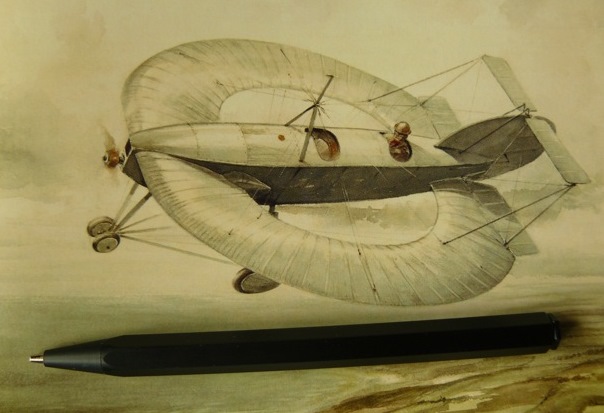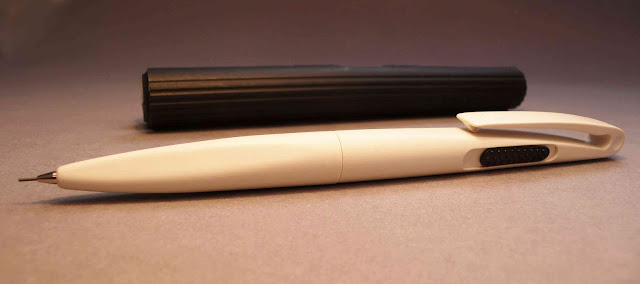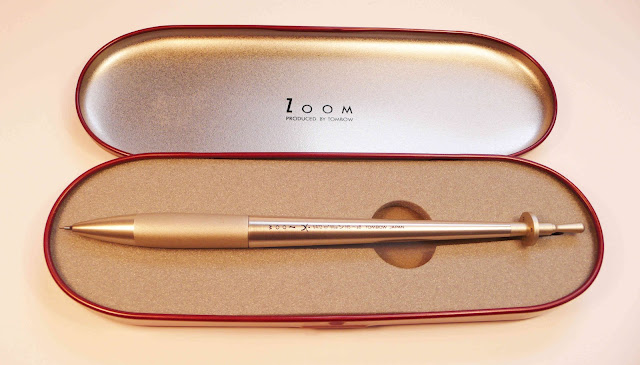Here we have the last of the feedback from the Dave Turns Five Giveaways. The Grand Finale Prize, a shopping spree at Cult Pens to the value of £150 was won by "Stell" and here now is an article she has sent in about her prize. So, over to Stell.Review of Wörther Slight 1.18mm Mechanical Pencil
130mm long, 9mm diameter, 18g, Price Range - Mid/High
Disclosure : this pencil was part of a prize in the celebrations of Dave’s Mechanical Pencil Blog turning Five.
Why did I choose the Wörther Slight Pencil?
Well ‘back in the day’ I worked in a Engineering drafting office (the early 1980’s), when mechanical drafting pencils came in 0.3, 0.5, 0.7 and 0.9mm and each draftsman was issued with a complete set on day one. We were also issued with two 2mm clutch pencils. All drawings were completed using the mechanical pencils, selecting the lead size for different thickness lines on the drawing to indicate different materials or construction details. Final drawings were inked in, using pens with the same line thicknesses. Those pencils were held perfectly vertical and rotated as one drew lines to ensure the line was always of a constant thickness. Any text or writing was done with a 2mm pencil. I left engineering for academia in the late 80’s but I just can’t bring myself to use a pencil in the sub 0.9mm category for anything other than technical line drawings, even though I know that a 0.5mm lead has become the default standard for most mechanical pencil users for writing. I simply enjoy the line variation that a 0.9 and 1.18mm pencil provides when writing and sketching. When I spotted the Wörther Slight Pencil at Cult Pens, I was curious to try out a modern production 1.18mm pencil, and I’m so glad that Dave’s birthday celebrations provided the impetus to order one.
First Impressions
The Wöether Slight comes packaged in a stylish, almost too stylish grey cardboard box.
![]()
The outer sleeve is in fine ribbed corrugated cardboard with the Wörther logo centred in reverse silver. The sleeve slides open to reveal a sleek black pencil and two information cards. Everything about this packaging is elegant and in keeping with my understanding of current EU regulations on manufacturers responsibility on providing packaging and products that are recyclable. There is not a plastic tie, band, or bag to be seen, only cardboard. Right on top was a small thick white card detailing the 3 steps to replace the leads. In an era where what Dave calls ‘keep on clicking’ 0.5mm pencils dominate the market, having this information readily available is probably a good move. The reverse of the card has the same instructions in German, well I suppose they are the same as German is not one of my languages. Also on top of the pencil is neat little folded card explaining the pencil is manufactured by hand, to a high standard, comes with a world wide guarantee and a ‘wish for great pleasure with Wörther products’. There is a link to the
Wörther website which lists some lovely pencil products. That site was enough to make me wish for an executive desk on which to display such things.
But what about the pencil? Well the first visual impression is that it is a classic pencil shape, hexagonal with a sharp taper at the writing end just like a wood cased pencil. Picking up the pencil there is a sense of weight, of quality; the pencil is metal and weighty, at 18g. My heavier vintage fountain pens weigh in at between 19.4 and 24 g, and a wood cased Faber-Castell 6B at 5g. The Wörther Slight feels substantial, cool to the touch, smooth and heavy, but is of course much thicker than a wood cased pencil, at 9mm diameter is more like a fountain pen, or significant ballpoint/roller ball pen.
The Wörther Slight is available in two finishes, Aluminium and Black. I ordered the Black with some slight apprehension about the matt black marking with finger smudges, but after several weeks of constant use there are no noticeable smears or marks. Unlike many mechanical pencils there is no special grip section or grip area. You can hold the pencil anywhere that suits you best, if anything the pencil is too smooth, initially the cool metal finish felt very smooth, almost slippery, but after using the pencil for a few weeks I realised that even though it felt slippery it wasn’t. This is a sleek pencil, with no pocket clip. Many pencils have pocket clips to prevent them rolling off a desk, as well as to clip them to pockets, but as this is a hexagonal pencil there is no risk of desk roll. I don’t clip pens and pencils to my self, in the past I have even amputated clips from some cheaper plastic pens and pencils because I disliked the way the clip interrupts the design. The lack of a pocket clip was something I liked about the Wörther (YMMV). The balance point is 65mm from the tip, exactly half way, making for a nicely secure feel in use.
![]()
, a 1.18mm, is advanced by a twist mechanism, as is common in many vintage pencils taking this size. To advance the lead you twist the nose cone of the pencil until enough lead protrudes for your use. A firm hold is required to twist the nose cone enough to advance lead, which may annoy if your fingers are not so nimble or are perhaps prone to slipping. The twist mechanism isn’t always obvious on vintage pencils, on some the mechanism is cap activated (push-click) or the twist mechanism is at the non-writing end of the pencil so there is always a sense of discovery as one works out how to advance the lead. The supplied lead is soft, possibly a 2B. Replacement leads are available from Wörther, in the same grade as supplied with the pencil, Autopoint 1.1mm leads fit and are available in H, HB, as well as Blue, Red and Green. Scripto leads fit and come in H, B, 2B, and CX supersoft leads, as well as Red, Green and Blue. 1.18mm leads are not commonly available where I live but are easy and affordable to buy online, and vintage and usable packets are often found ‘in the wild’ in antique or used goods shops.
Spare lead access, is at the non-working end of the pencil where there is a hexagonal plug, with Wörther and Germany etched on it. This is the only branding on the entire pencil, unlike much of the commercial pencil offerings which are branded, bar-coded, logo’d and have lead sizes and other information liberally applied to the entire surface of the pencil barrel, and clip.
Removing the hexagonal plug reveals an eraser so small that it could only be considered an emergency eraser and a black rubber tube plugged with a grey stopper. This tube contains spare on-board leads, and prevents the classic mechanical pencil rattle sound from occurring. I can’t help but think of this as a stealth pencil, rugged, silent, and dark.
Leads are replaced by removing the old lead stub, fully retracting the lead mechanism and inserting a new lead thru the nose cone before tamping it home gently with a firm push against a hard surface.
Second impressions, after a few weeks of constant use. The all-important use test. The pencil has a conical lead sleeve so is a writing and free-drawing pencil rather than a drafting or technical pencil. The supplied lead is soft and generous so writes like a classic wood cased pencil, but can be sharpened or rotated to write with a fine line. What I like about 1.18mm leads is they are thick enough lead to last a while and to give you options. I have been known to use a lead pointer to sharpen the lead to a point, or drafting sandpaper block to smooth the lead to a chisel suitable for italic writing.
My only negative comment about the pencil is that the hexagonal shape is sharp, the edges are very noticeable when handling the pencil but not at all noticeable when using the pencil, so hardly bears mentioning. In contrast my Black Fixpencil 22 is a similar shape and material but far slimmer and the edges are much more rounded.
Did this pencil live up to my expectations?
Good question, as well as my drafting office inititation into the world of quality mechanical pencils, my expectations were also based on a small collection of very nice vintage pencils I have and use daily. My collection consists of a few Conway Stewart Duropoints, a Scripto, Parker 51 pencil, two Burnhams, some Autopoints, a Koh-i-nor, and a Fixpencil. All those are well made, comfortable to use and by their age alone have stood the test of time and use. The Wörther Slight certainly feels like it is in the same league in terms of build quality and durability. Compared to my vintage pencil collection there is a different aesthetic with the Wörther Slight, it is without a doubt a markedly more modernistic pencil, showcasing ideas of form follows function and total absence of any decoration in the design. If I was at a meeting and some one borrowed my Wörther Slight to jot down a note or two… I can imagine their sense of discovery that this uber-conservative pencil was a lot more than they expected. The Wörther Slight is already one of my favourite pencils and I expect it will age well.
Again – a huge thank you to Dave and his blog, to Cult Pens, and all Dave’s blog followers which allow me to experience not only the Wörther Slight but also to indulge my love of quality writing instruments at a technical geek level.
Stella aka
KnitknitfrogThanks Stella, a great read, and I'm glad you enjoyed the fruits of your shopping spree. Stella also sent in this photo of the whole spree. Dave.A full list of the items pictured is here on Knit Knit Frog



























